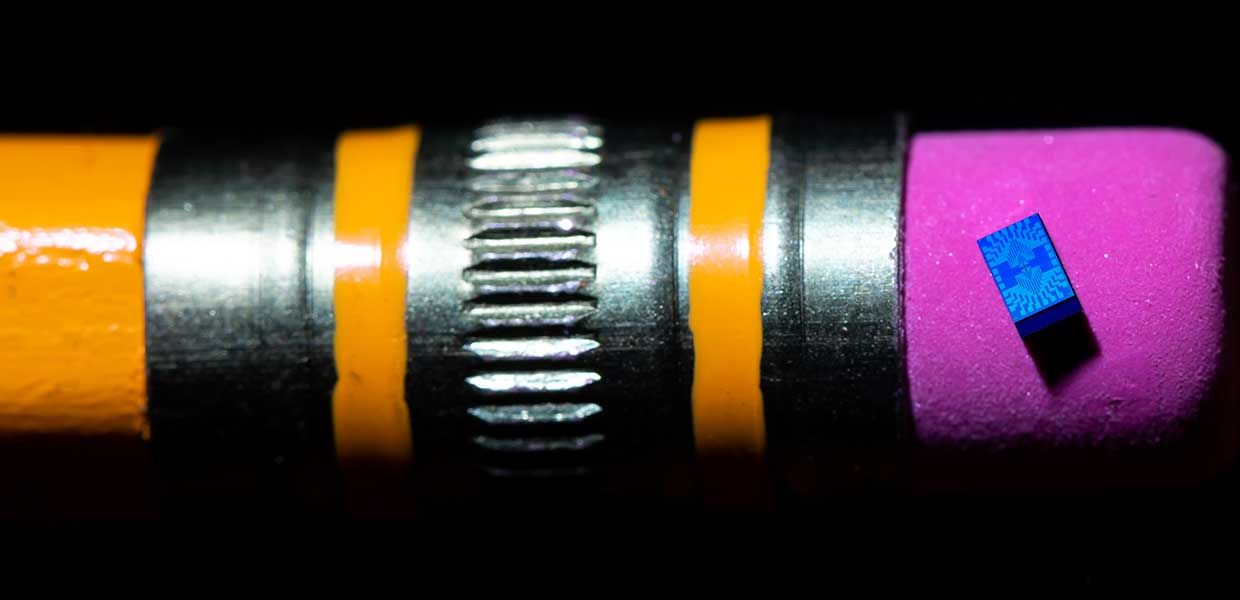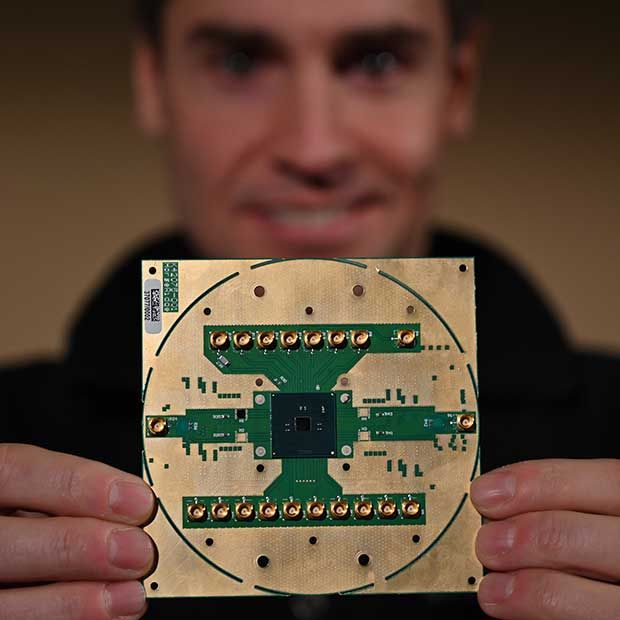What Intel Is Planning for The Future of Quantum Computing: Hot Qubits, Cold Control Chips, and Rapid Testing
Quantum computing may have shown its supremacy" over classical computing a little over a year ago, but it still has a long way to go. Intel's director of quantum hardware, Jim Clarke, says that quantum computing will really have arrived when it can do something unique that can change our lives, calling that point quantum practicality." Clarke talked to IEEE Spectrum about how he intends to get silicon-based quantum computers there:
Jim Clarke on...
- Why quantum computers will be made of silicon
- How silicon spin qubits work
- What needs to happen before quantum error correction works
- Hot" silicon spin qubits
- What problems keeps him up at night
IEEE Spectrum: Intel seems to have shifted focus from quantum computers that rely on superconducting qubits to ones with silicon spin qubits. Why do you think silicon has the best chance of leading to a useful quantum computer?

Jim Clarke: It's simple for us... Silicon spin qubits look exactly like a transistor. ... The infrastructure is there from a tool fabrication perspective. We know how to make these transistors. So if you can take a technology like quantum computing and map it to such a ubiquitous technology, then the prospect for developing a quantum computer is much clearer.
I would concede that today silicon spin-qubits are not the most advanced quantum computing technology out there. There has been a lot of progress in the last year with superconducting and ion trap qubits.
But there are a few more things: A silicon spin qubit is the size of a transistor-which is to say it is roughly 1 million times smaller than a superconducting qubit. So if you take a relatively large superconducting chip, and you say how do I get to a useful number of qubits, say 1000 or a million qubits?" all of a sudden you're dealing with a form factor that is ... intimidating.
We're currently making server chips with billions and billions of transistors on them. So if our spin qubit is about the size of a transistor, from a form-factor and energy perspective, we would expect it to scale much better.
Spectrum: What are silicon spin-qubits and how do they differ from competing technology, such as superconducting qubits and ion trap systems?
Clarke: In an ion trap you are basically using a laser to manipulate a metal ion through its excited states where the population density of two excited states represents the zero and one of the qubit. In a superconducting circuit, you are creating the electrical version of a nonlinear LC (inductor-capacitor) oscillator circuit, and you're using the two lowest energy levels of that oscillator circuit as the zero and one of your qubit. You use a microwave pulse to manipulate between the zero and one state.
We do something similar with the spin qubit, but it's a little different. You turn on a transistor, and you have a flow of electrons from one side to another. In a silicon spin qubit, you essentially trap a single electron in your transistor, and then you put the whole thing in a magnetic field [using a superconducting electromagnet in a refrigerator]. This orients the electron to either spin up or spin down. We are essentially using its spin state as the zero and one of the qubit.
That would be an individual qubit. Then with very good control, we can get two separated electrons in close proximity and control the amount of interaction between them. And that serves as our two-qubit interaction.
So we're basically taking a transistor, operating at the single electron level, getting it in very close proximity to what would amount to another transistor, and then we're controlling the electrons.
Spectrum: Does the proximity between adjacent qubits limit how the system can scale?
Clarke: I'm going to answer that in two ways. First, the interaction distance between two electrons to provide a two-qubit gate is not asking too much of our process. We make smaller devices every day at Intel. There are other problems, but that's not one of them.
Typically, these qubits operate on a sort of a nearest neighbor interaction. So you might have a two-dimensional grid of qubits, and you would essentially only have interactions between one of its nearest neighbors. And then you would build up [from there]. That qubit would then have interactions with its nearest neighbors and so forth. And then once you develop an entangled system, that's how you would get a fully entangled 2D grid. [Entanglement is a condition necessary for certain quantum computations.]
 Photo: Walden Kirsch/Intel Corp. An Intel silicon spin qubit chip balances on a pencil eraser.
Photo: Walden Kirsch/Intel Corp. An Intel silicon spin qubit chip balances on a pencil eraser. Spectrum: What are some of the difficult issues right now with silicon spin qubits?
Clarke: By highlighting the challenges of this technology, I'm not saying that this is any harder than other technologies. I'm prefacing this, because certainly some of the things that I read in the literature would suggest that qubits are straightforward to fabricate or scale. Regardless of the qubit technology, they're all difficult.
With a spin qubit, we take a transistor that normally has a current of electrons go through, and you operate it at the single electron level. This is the equivalent of having a single electron, placed into a sea of several hundred thousand silicon atoms and still being able to manipulate whether it's spin up or spin down.
So we essentially have a small amount of silicon, we'll call this the channel of our transistor, and we're controlling a single electron within that that piece of silicon. The challenge is that silicon, even a single crystal, may not be as clean as we need it. Some of the defects-these defects can be extra bonds, they can be charge defects, they can be dislocations in the silicon-these can all impact that single electron that we're studying. This is really a materials issue that we're trying to solve.
We're going to put together a bunch of real qubits and have them function as one very good logical qubit.Spectrum: Just briefly, what is coherence time and what's its importance to computing?
Clarke: The coherence time is the window during which information is maintained in the qubit. So, in the case of a silicon spin qubit, it's how long before that electron loses its orientation, and randomly scrambles the spin state. It's the operating window for a qubit.
Now, all of the qubit types have what amounts to coherence times. Some are better than others. The coherence times for spin qubits, depending on the type of coherence time measurement, can be on the order of milliseconds, which is pretty compelling compared to other technologies.
What needs to happen [to compensate for brief coherence times] is that we need to develop an error correction technique. That's a complex way of saying we're going to put together a bunch of real qubits and have them function as one very good logical qubit.
Spectrum: How close is that kind of error correction?
Clarke: It was one of the four items that really needs to happen for us to realize a quantum computer that I wrote about earlier. The first is we need better qubits. The second is we need better interconnects. The third is we need better control. And the fourth is we need error correction. We still need improvements on the first three before we're really going to get, in a fully scalable manner, to error correction.
You will see groups starting to do little bits of error correction on just a few qubits. But we need better qubits and we need a more efficient way of wiring them up and controlling them before you're really going to see fully fault-tolerant quantum computing.
Spectrum: One of the improvements to qubits recently was the development of hot" silicon qubits. Can you explain their significance?
Clarke: Part of it equates to control.
Right now you have a chip at the bottom of a dilution refrigerator, and then, for every qubit, you have several wires that that go from there all the way outside of the fridge. And these are not small wires; they're coax cables. And so from a form factor perspective and a power perspective-each of these wires dissipates power-you really have a scaling problem.
 Photo: Walden Kirsch/Intel Corp. Stefano Pellerano, principal engineer at Intel Labs, holds Horse Ridge, a cryogenic control chip.
Photo: Walden Kirsch/Intel Corp. Stefano Pellerano, principal engineer at Intel Labs, holds Horse Ridge, a cryogenic control chip. One of the things that Intel is doing is that we are developing control chips. We have a control chip called Horse Ridge that's a conventional CMOS chip that we can place in the fridge in close proximity to our qubit chip. Today that control chip sits at 4 kelvins and our qubit chip is at 10 millikelvins and we still have to have wires between those two stages in the fridge.
Now, imagine if we can operate our qubit slightly warmer. And by slightly warmer, I mean maybe 1 kelvin. All of a sudden, the cooling capacity of our fridge becomes much greater. The cooling capacity of our fridge at 10 millikelvin is roughly a milliwatt. That's not a lot of power. At 1 Kelvin, it's probably a couple of Watts. So, if we can operate at higher temperatures, we can then place control electronics in very close proximity to our qubit chip.
By having hot qubits we can co-integrate our control with our qubits, and we begin to solve some of the wiring issues that we're seeing in today's early quantum computers.
What we're trying to do ... is put us on a path to scaling that will get us to a useful quantum computer that will change your life or mine.Spectrum: Are hot qubits structurally the same as regular silicon spin qubits?
Clarke: Within silicon spin qubits there are several different types of materials, some are what I would call silicon MOS type qubits- very similar to today's transistor materials. In other silicon spin qubits you have silicon that's buried below a layer of silicon germanium. We'll call that a buried channel device. Each have their benefits and challenges.
We've done a lot of work with TU Delft working on a certain type of [silicon MOS] material system, which is a little different than most in the community are studying [and lets us] operate the system at a slightly higher temperature.
I loved the quantum supremacy work. I really did. It's good for our community. But it's a contrived problem, on a brute force system, where the wiring is a mess (or at least complex).
What we're trying to do with the hot qubits and with the Horse Ridge chip is put us on a path to scaling that will get us to a useful quantum computer that will change your life or mine. We'll call that quantum practicality.
Spectrum: What do you think you're going to work on next most intensely?
Clarke: In other words, What keeps Jim up at night?"
There are a few things. The first is time-to-information. Across most of the community, we use these dilution refrigerators. And the standard way [to perform an experiment] is: You fabricate a chip; you put it in a dilution refrigerator; it cools down over the course of several days; you experiment with it over the course of several weeks; then you warm it back up and put another chip in.
Compare that to what we do for transistors: We take a 300-millimeter wafer, put it on a probe station, and after two hours we have thousands and thousands of data points across the wafer that tells us something about our yield, our uniformity, and our performance.
That doesn't really exist in quantum computing. So we asked, Is there way to-at slightly higher temperatures-to combine a probe station with a dilution refrigerator?" Over the last two years, Intel has been working with two companies in Finland [Bluefors Oy and Afore Oy] to develop what we call the cryoprober. And this is just coming online now. We've been doing an impressive job of installing this massive piece of equipment in the complete absence of field engineers from Finland due to the Coronavirus.
 Photo: Bluefors Built by Intel, Bluefors, and Afore, the first cryogenic wafer prober is designed to rapidly test qubits needed for quantum computing. The prober, the first tool of its kind, can test qubits on an entire 300-mm wafers at temperatures of just a few kelvins.
Photo: Bluefors Built by Intel, Bluefors, and Afore, the first cryogenic wafer prober is designed to rapidly test qubits needed for quantum computing. The prober, the first tool of its kind, can test qubits on an entire 300-mm wafers at temperatures of just a few kelvins. What this will do is speed up our time-to-information by a factor of up to 10,000. So instead of wire bonding a single sample, putting it in the fridge, taking a week to study it, or even a few days to study it, we're going to be able to put a 300-millimeter wafer into this unit and over the course of an evening step and scan. So we're going to get a tremendous increase in throughput. I would say a 100 X improvement. My engineers would say 10,000. I'll leave that as a challenge for them to impress me beyond the 100.
Here's the other thing that keeps me up at night. Prior to starting the Intel quantum computing program, I was in charge of interconnect research in Intel's Components Research Group. (This is the wiring on chips.) So, I'm a little less concerned with the wiring into and out of the fridge than I am just about the wiring on the chip.
I'll give an example: An Intel server chip has probably north of 10 billion transistors on a single chip. Yet the number of wires coming off that chip is a couple of thousand. A quantum computing chip has more wires coming off the chip than there are qubits. This was certainly the case for the Google [quantum supremacy] work last year. This was certainly the case for the Tangle Lake chip that Intel manufactured in 2018, and it's the case with our spin qubit chips we make now.
So we've got to find a way to make the interconnects more elegant. We can't have more wires coming off the chip than we have devices on the chip. It's ineffective.
This is something the conventional computing community discovered in the late 1960s with Rent's Rule [which empirically relates the number of interconnects coming out of a block of logic circuitry to the number of gates in the block]. Last year we published a paper with Technical University Delft on the quantum equivalent of Rent's Rule. And it talks about, amongst other things the Horse Ridge control chip, the hot qubits, and multiplexing.
We have to find a way to multiplex at low temperatures. And that will be hard. You can't have a million-qubit quantum computer with two million coax cables coming out of the top of the fridge.
Spectrum: Doesn't Horse Ridge do multiplexing?
Clarke: It has multiplexing. The second generation will have a little bit more. The form factor of the wires [in the new generation] is much smaller, because we can put it in closer proximity to the [quantum] chip.
So if you kind of combine everything I've talked about. If I give you a package that has a classical control chip-call it a future version of Horse Ridge-sitting right next to and in the same package as a quantum chip, both operating at a similar temperature and making use of very small interconnect wires and multiplexing, that would be the vision.
Spectrum: What's that going to require?
Clarke: It's going to require a few things. It's going to require improvements in the operating temperature of the control chip. It's probably going to require some novel implementations of the packaging so there isn't a lot of thermal cross talk between the two chips. It's probably going to require even greater cooling capacity from the dilution refrigerator. And it's probably going to require some qubit topology that facilitates multiplexing.
Spectrum: Given the significant technical challenges you've talked about here, how optimistic are you about the future of quantum computing?
Clarke: At Intel, we've consistently maintained that we are early in the quantum race. Every major change in the semiconductor industry has happened on the decade timescale and I don't believe quantum will be any different. While it's important to not underestimate the technical challenges involved, the promise and potential are real. I'm excited to see and participate in the meaningful progress we're making, not just within Intel but the industry as a whole. A computing shift of this magnitude will take technology leaders, scientific research communities, academia, and policy makers all coming together to drive advances in the field, and there is tremendous work already happening on that front across the quantum ecosystem today.